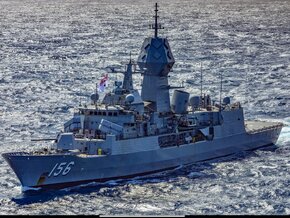I've not heard that adding NSM has taken any RN ships out of service for a year. There was a gap between the announcement & work starting, & any CMS changes would only need to be designed once - & that was done in that year.
HMS Richmond got NSM last month, & is heading to the Pacific soon. She spent last year being busy in the Red Sea, the Atlantic, & the English Channel. She's certainly not been out of service for a year.
HMS Somerset was in & out of service in the year between the announcement of NSM procurement & IOC, but that wasn't due to NSM. She'd just had a refit, & there were problems with it. That's serious, & worrying, but wasn't caused by NSM. The other way round: her post-refit faults are reported to have delayed IOC with NSM.
There are a bunch of unknowns though, which could make carrying out the installation and integration of NSM on Kiwi frigates somewhat more complicated and/or somewhat less straightforward than the experiences of other nations. Please keep in mind though that I am also acknowledging that it might also be the case that these potential issues might not exist either.
One difference to start with between RN Type 23 frigates and the Kiwi version
ANZAC-class frigates is that whilst the Type 23's were originally armed with two quad Harpoon AShM cannisters, the Kiwi frigates at one point were FFBNW space for Harpoon cannisters. This in turn means that the Kiwi frigates might not have any of the mounting or wiring/connecting points to fit any ship-launched AShM at this point, or it might not be in a position that is effective. Again going from memory, the original FFBNW plan had set aside real estate to mount a pair of quad Harpoon cannisters facing port and starboard amidships just forward of the mast. As can be seen looking at RAN
ANZAC-class frigates, it was decided to install the quad cannister elsewhere instead. The certainly lets us know that the position just forward of the bridge can take AShM, but it would require some work to get the area there ready for missile cannisters to be installed and wired into the rest of the ship. What we do not know (though actually there might be a couple of people here who actually do know) is just what was required to physically have that space ready for the cannisters. Is it a fairly simple matter or running some power and networking wires to where the cannisters will be, plus some prepping of the deck and bridge windows to handle the hot exhaust of a missile launch, or is it something more complex? If the deck beneath where the cannister are to sit needs reinforcement to handle stresses exerted by missiles during launch and/or a change in the layout or the contents of the compartment immediately beneath where the launcher is to be need to be moved or rearranged in order to fit the appropriate connections, that might require structural changes done in a yard.
There are also the questions relating to the integration of the NSM into LockMart Canada's CMS330 and what, if any other changes to shipboard electronics would be required. One of the questions is simply, would an NSM installation require another weapons work station get installed into the CIC or bridge, or would an existing station be able to get re-purposed to control the AShM? If another station would need to be installed, do the Kiwi frigates have space for it in the bridge or CIC, wherever the ship would be 'fought' from? As for the integration with the CMS, is that something which NZ could do themselves, domestically? Or would the vessels need to transit back to BC where the sensors and CMS where changed/installed in the first place?
Again, not saying fitting NSM cannot or should not happen, but am pointing out that there are multiple potential issues which could make the idea a bad one. I would also point out that at this point I do not feel that RAN FFGH's could be used as a reference design, since the internals for the two variants of frigate have some of their internal layouts diverge starting back in 2007 with the NZ Platform Systems Upgrade which saw some compartment configurations change.



